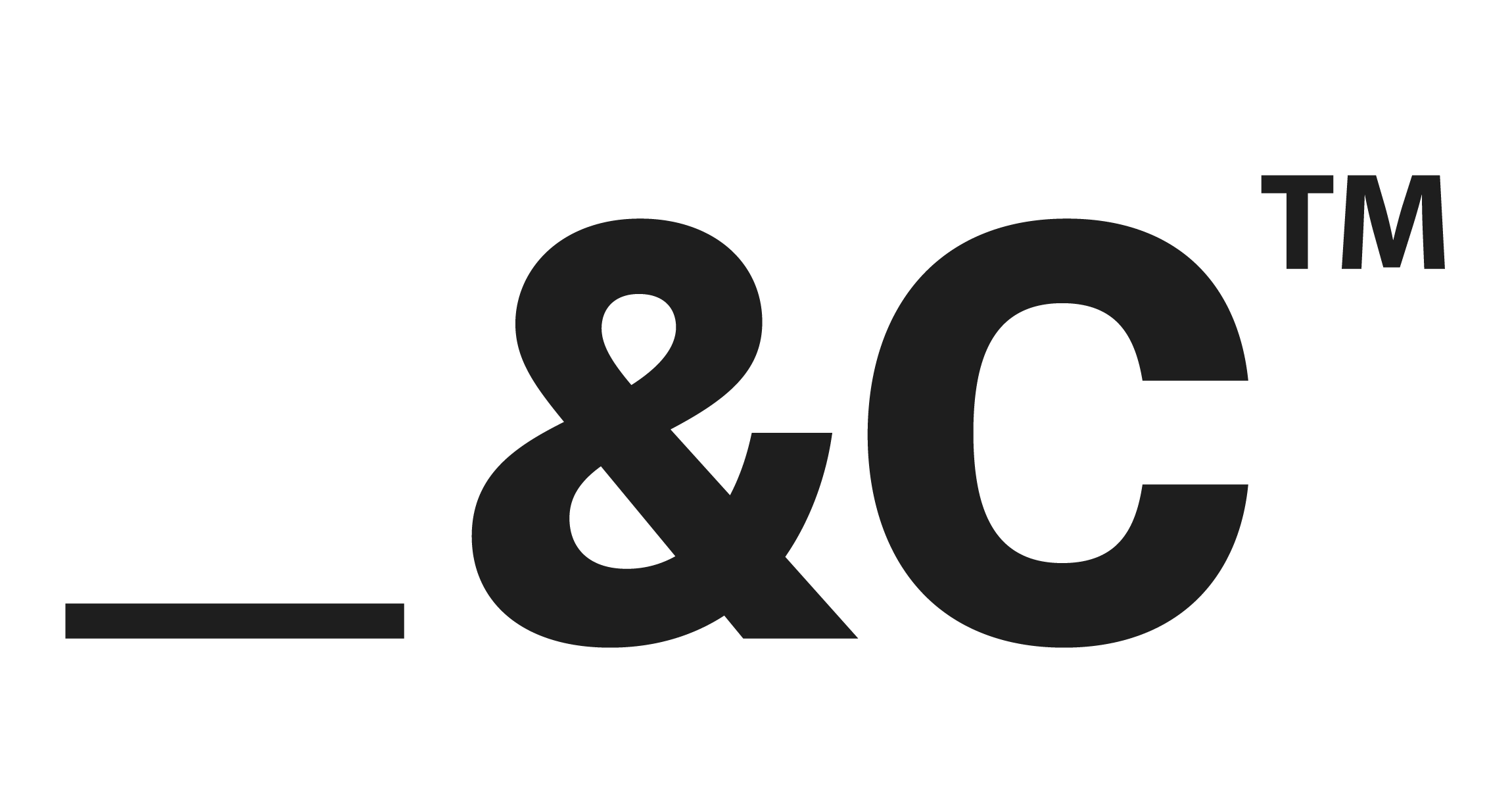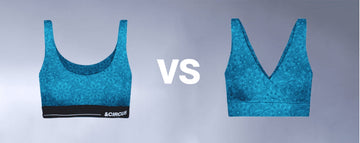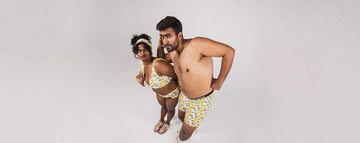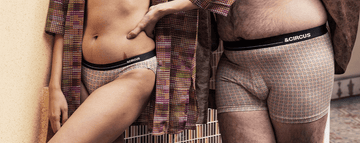Quick Listen:
Imagine stepping into a vibrant boutique in Mumbai, where rows of lingerie gleam under warm lighting, offering sizes that embrace every curve and contour imaginable. This scene isn't just a retail display it's a symbol of a profound transformation sweeping through India's fashion world. The body positivity movement is dismantling long-held stereotypes, urging brands to celebrate diversity rather than conformity. As consumers across the nation demand apparel that reflects their real lives, the innerwear sector stands at the forefront of this change, with innovative labels like dCircus pioneering a path toward greater self-expression and acceptance.
Uncomfortable underwear shouldn't steal your confidence. At Andcircus, we craft ultra-soft, sustainable Lenzing Modal Micro® innerwear for every body, XS to 5XL. From briefs to bras, our custom packs fit you perfectly. Shop risk-free with our 100% satisfaction guarantee and embrace comfort that includes everyone. #LoveEveryBody. Shop Now!
A Cultural Awakening
The roots of body positivity in India trace back to global influences, but they've taken on a distinctly local flavor. Once dominated by Western ideals of slender figures and fair complexions, the Indian fashion scene is now buzzing with calls for inclusivity. Social media platforms have become battlegrounds for change, with hashtags such as #LoveYourBody and #BodyPositivity gaining millions of views. Influencers from diverse backgrounds share raw, unedited stories of their journeys toward self-love, inspiring followers to reject outdated norms.
For decades, the industry perpetuated a narrow vision: slim waists, perfect proportions, and a limited color palette that ignored India's rich spectrum of skin tones. But shifting demographics are forcing a rethink. With a burgeoning middle class and rising disposable incomes, shoppers are no longer content with ill-fitting garments. They seek innerwear that provides comfort, style, and a sense of empowerment. This demand is particularly evident in the premium lingerie market, which reached USD 1.73 billion in 2024 and is forecasted to grow to USD 4.21 billion by 2033, at a CAGR of 9.60% from 2025 to 2033. Key factors fueling this expansion include heightened fashion awareness, a preference for high-quality materials, and the rise of body-positive marketing strategies.
Brands are increasingly incorporating messages of self-acceptance into their campaigns, showcasing models of all shapes and sizes. This isn't mere tokenism; it's a response to consumer voices amplified through digital channels. In cities like Delhi and Jaipur, stores report a surge in requests for size-inclusive options, reflecting a broader cultural shift where confidence trumps convention.
The Rise of Inclusive Fashion
Strolling through a modern mall in Bangalore or Kolkata, the evolution is palpable. Shelves once stocked with standard sizes now feature extended ranges, from petite to plus-size, catering to a multitude of body types. Adaptive designs think bras with adjustable features for varying needs are becoming commonplace, blending functionality with flair. This inclusivity extends beyond lingerie to related segments like athleisure, where comfort meets everyday style.
The India plus-size clothing market exemplifies this trend, valued at USD 10,075.39 million in 2023 and projected to reach USD 18,286.77 million by 2032, growing at a CAGR of 6.84% from 2024 to 2032. Driving this are demands for inclusive fashion, greater awareness of body positivity, and an expanding middle class with more spending power. Urbanization and e-commerce have accelerated access, particularly in metro areas like Delhi, Mumbai, and Bangalore, which lead the charge. However, Tier 2 and Tier 3 cities are catching up rapidly, thanks to online platforms bridging geographical gaps. West India commands the largest share at 32%, closely followed by North India at 30%, while East India shows steady progress.
Recent developments underscore this momentum. In January 2025, H&M expanded its plus-size offerings up to 4XL for women and 3XL for men, responding to consumer feedback. Similarly, Capri Holdings reevaluated its strategies in February 2025 to boost sales in this segment. These moves highlight how global brands are adapting to Indian preferences, offering not just variety but also culturally resonant designs.
Social media's role cannot be overstated. Influencers post authentic content, from lingerie hauls to athleisure outfits, fostering dialogues on self-acceptance. This has pressured brands to diversify their representations, featuring models across ages, skin tones, and body shapes a far cry from the uniform imagery of yesteryears. For instance, a lingerie launch in a Tier-2 city featuring plus-size models in bold, practical pieces sold out quickly, proving the market's appetite for such innovations.
Athleisure is another beneficiary of this wave. The India athleisure market, estimated at USD 35.71 million in 2023, is set to expand from USD 39.29 million in 2024 to USD 114 million by 2035, with a CAGR of 10.168% during 2025-2035. Trends like increased health awareness, e-commerce growth, and celebrity endorsements via social media are propelling this sector. Millennials and Gen Z, prioritizing wellness, blend gym attire with casual wear, seeking versatile pieces that empower them in various settings from fitness classes to office environments.
Challenges on the Horizon
Despite the progress, hurdles persist. Established brands, rooted in conventional aesthetics, find it difficult to overhaul their operations. Scaling production for diverse sizes demands significant investment in new patterns, fabrics, and supply chains costs that smaller manufacturers may struggle to absorb. Infrastructure limitations exacerbate this, with many factories ill-equipped for rapid adaptation.
Cultural barriers add complexity. In a society where discussions about innerwear remain taboo in many circles, promoting body positivity requires sensitivity. Households across India, especially in rural and conservative areas, still view such topics as private, hindering open conversations. The urban-rural divide is stark: while metros like Chennai embrace change, smaller towns lack physical access to inclusive products, relying heavily on online options that may not always deliver the tactile experience needed for intimate apparel.
Social stigma lingers, too. Even as the body positivity movement gains traction, some face backlash for defying norms. Retailers in Tier-2 and Tier-3 locales note customer reluctance to experiment with bold designs, underscoring that societal shifts unfold gradually. As a boutique owner in Lucknow observed, enthusiasm for inclusivity exists, but adoption varies widely.
Moreover, the French-language counterpart of this discussion echoes similar sentiments, emphasizing how the movement challenges narrow ideals and pushes for broader representation. Quotes from industry leaders like Anita Dongre highlight the demand for inclusive sizing, while brands such as aLL offer ranges from 2XL to 8XL, aiming to foster confidence.
Opportunities in a Shifting Market
For forward-thinking brands like dCircus, these obstacles present fertile ground for innovation. By embracing inclusivity, they access untapped segments plus-size shoppers in semi-urban regions or eco-conscious Gen Z consumers. Sustainability emerges as a pivotal driver in the premium lingerie space, with preferences for organic cotton, bamboo, and recycled materials on the rise. In 2023, 14,676 facilities worldwide were certified under the Global Organic Textile Standard (GOTS), marking an 8% year-over-year increase. GOTS's partnership with the European Space Agency to map Indian cotton fields enhances traceability, benefiting the world's top organic cotton supplier.
E-commerce is reshaping market dynamics, fueled by rapid internet penetration and the widespread adoption of smartphones. This digital surge is empowering direct-to-consumer models, where brands connect with niche audiences through personalized experiences and compelling storytelling. The result is a more interactive, accessible, and customer-centric retail landscape that continues to expand its influence across industries. Customization thrives here, from AI-powered fit tools to virtual try-ons, ensuring better matches and reducing returns.
The payoff is evident. Campaigns featuring diverse models, like Clovia's plus-size bra launch in September 2024 (sizes 32B to 44F), generate buzz and loyalty. Inclusive ads often surpass traditional ones in engagement, building trust and community. For dCircus, this translates to a competitive edge in a saturated market, where authenticity wins consumer allegiance.
Designers like Masaba Gupta advocate for fashion as self-expression, while initiatives from The Plus Size Store use 3D scans for tailored patterns, breaking stigmas. As Manish Saksena notes, embracing inclusivity taps into growing markets, rewarding brands with devoted followings and enhanced reputations.
A New Standard for Beauty
Looking ahead, India's fashion horizon appears inclusive and vibrant. Experts foresee body-positive approaches becoming industry staples, integrated into every facet from design to marketing. Brands like dCircus lead by example, creating innerwear that prioritizes expression alongside utility. Yet, success demands ongoing commitment: bolstering supply chains for diversity, educating teams on customer empathy, and crafting narratives that echo India's multifaceted culture.
As outdated standards fade, a fresh narrative emerges one of empowerment and variety. It's embodied in a Chennai woman's perfect-fitting bra or an Ahmedabad teen's curve-celebrating athleisure. The movement, as explored in Body Positivity Reshapes Fashion Narratives in India's Innerwear Sector, isn't confined to trends; it's redefining beauty's essence. For attuned brands, the lesson is profound: inclusivity drives not only sales but societal progress.
Frequently Asked Questions
How is the body positivity movement changing India's lingerie and innerwear market?
The body positivity movement is driving significant growth in India's premium lingerie market, which reached USD 1.73 billion in 2024 and is projected to grow to USD 4.21 billion by 2033. Brands are now offering extended size ranges, featuring diverse models in campaigns, and creating adaptive designs that cater to different body types. This shift from Western beauty ideals to inclusive fashion is being fueled by consumer demand for comfort, style, and empowerment through social media advocacy and changing demographics.
What is the size of India's plus-size clothing market and which cities are leading this trend?
India's plus-size clothing market was valued at USD 10,075.39 million in 2023 and is expected to reach USD 18,286.77 million by 2032, growing at a CAGR of 6.84%. West India commands the largest market share at 32%, followed by North India at 30%. Metro cities like Delhi, Mumbai, and Bangalore are leading the charge, though Tier 2 and Tier 3 cities are rapidly catching up through e-commerce platforms that bridge geographical gaps.
What challenges do fashion brands face when implementing body-positive and inclusive sizing in India?
Brands face several challenges including high investment costs for scaling production across diverse sizes, requiring new patterns, fabrics, and supply chain modifications. Cultural barriers persist as innerwear discussions remain taboo in many conservative areas, creating an urban-rural divide in acceptance. Additionally, established brands rooted in conventional aesthetics struggle to overhaul operations, while social stigma and customer reluctance to experiment with bold designs slow adoption, particularly in smaller towns.
Disclaimer: The above helpful resources content contains personal opinions and experiences. The information provided is for general knowledge and does not constitute professional advice.
You may also be interested in: Role of the Fashion Industry in Shaping Body Image
Uncomfortable underwear shouldn't steal your confidence. At Andcircus, we craft ultra-soft, sustainable Lenzing Modal Micro® innerwear for every body, XS to 5XL. From briefs to bras, our custom packs fit you perfectly. Shop risk-free with our 100% satisfaction guarantee and embrace comfort that includes everyone. #LoveEveryBody. Shop Now!


















































